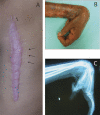Hypertrophic scar formation following burns and trauma: new approaches to treatment
- PMID: 17803351
- PMCID: PMC1961631
- DOI: 10.1371/journal.pmed.0040234
Hypertrophic scar formation following burns and trauma: new approaches to treatment
Abstract
The authors examine the process of hypertrophic scar formation, the results of current treatments, and areas of research likely to lead to significant advances in the field.
Conflict of interest statement
Figures


References
-
- Brigham PA, McLoughlin E. Burn incidence and medical care use in the United States: Estimates, trends, and data sources. J Burn Care Rehabil. 1996;17:95–107. - PubMed
-
- National Highway Traffic Safety Administration. Traffic safety facts 2004. 2004. US Department of Transportation. Available: http://www-nrd.nhtsa.dot.gov/pdf/nrd-30/NCSA/TSFAnn/TSF2004.pdf. Accessed 1 August 2007.
-
- Merrill CT, Elixhauser A. Healthcare Cost and Utilization Project: Procedures in U.S. hospitals, 2003. 2003. Agency for Healthcare Research and Quality. Available: http://www.ahrq.gov/data/hcup/factbk7/. Accessed 1 August 2007.
-
- MedMarket Diligence. Worldwide wound management, 2005–2014: Established and emerging products, technologies and markets in the U.S., Europe, Japan and rest of world. Foothill Ranch (CA): MedMarket Diligence; 2005. 304
-
- WHO. Global Burden of Disease Project. 2002. Available: http://www.who.int/healthinfo/bodproject/en/index.html. Accessed 1 August 2007.
Publication types
MeSH terms
LinkOut - more resources
Full Text Sources
Other Literature Sources
Medical

